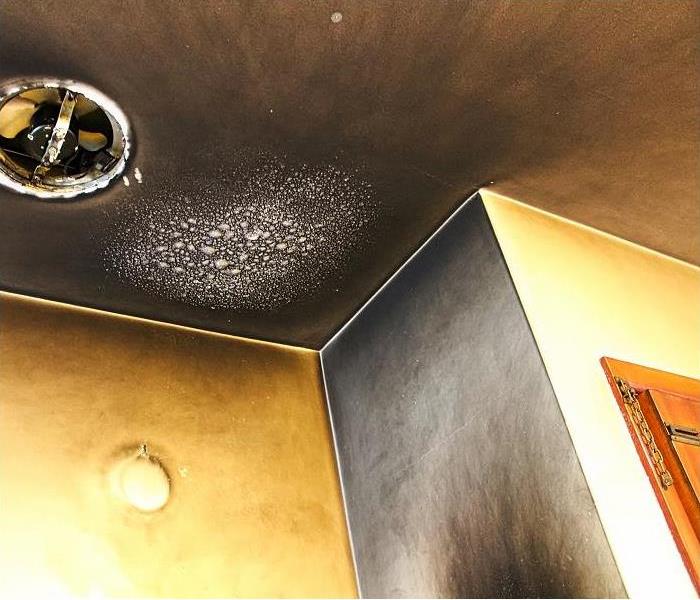What Is Soot and How Can It Damage Your Home?
9/29/2020 (Permalink)
 Smoke and soot damage are difficult to remove. SERVPRO knows how to remove the residue and restore your home.
Smoke and soot damage are difficult to remove. SERVPRO knows how to remove the residue and restore your home.
After a Disaster in Centereach Homes, There are Many Obstacles Like Soot That Professional Fire Restorers Face
Understanding the severity of a fire disaster in Centereach homes is rarely tricky, as structure fires can spread quickly through the property and destroy materials in its path. As relieving as it might initially be to get the fire extinguished, there are still many ways that the house's lingering effects can damage exposed surfaces, contents, and the occupants. One of the most prevalent and hazardous of these effects is soot in the damaged areas.
While there are multiple layers of fire damage in Centereach homes after a disaster, soot can often be one of the most destructive to manage. It is made of small carbon particles created when fuel types, like wood and other organic matter, did not fully combust during the fire. The results are acidic and often ionized particulates circulating in the environment that adhere to exposed surfaces and contents. They can even penetrate the HVAC system with its magnetism towards the sheet metal, vents, and registers. Whether stuck to surfaces or circulating in the environment, this threat must get addressed as soon as possible by competent professionals with the appropriate personal protective equipment like our SERVPRO team.
Can You Lessen the Severity of Soot?
It might be worth considering the potential avenues that could reduce the prolonged impacts of soot on the house over time. Fire restoration does not happen overnight, so prioritizing the steps that can reduce hazards for our SERVPRO technicians and any occupants of the house is vital. There are immediate steps that can get taken to lessen the presence of soot where it can get found in the property, including:
- Debris Removal – Ashes, remnants of partially combusted materials, and other debris are on the floors in the house's affected rooms. Shoveling out piles of this charred matter can reduce concentrations of circulating threats like soot and noxious odors.
- Dry Vacuuming – Residues can be thick on surfaces, especially when these elements are nearby to where the fire burned the longest and smoldered. Thick residues can sometimes benefit from dry vacuuming to remove the majority of surface particles before cleaning begins.
- Air Filtration – HEPA-filtration equipment like our air scrubbers can help capture circulating soot particles as small as 0.3 microns. By reducing the circulating soot, we can limit the damage to surfaces, restorers, and contents.
Where Is Soot Located?
While it is not uncommon to see residues and coatings on almost all exposed surfaces throughout the property after a Centereach fire, certain areas often get most of these damaging effects. Through convection and other scientific principles relative to the circulation of heated and cooler air, contaminated warm gases and smoke continually seek the highest points, which can often leave greater concentrations and thicker smoke residues on or in areas like:
- Ceilings – The constant push for heated air and smoke to rise can leave places like the drywall or plaster ceiling of your home coated with black soot residues.
- Walls – While residues could impact any portion of walls, upper halves towards the ceilings can often display a greater concentration of soot particles.
- HVAC System – With the ionization and magnetism of particles after the combustion of specific materials, the HVAC system can often draw in a considerable volume of soot particles and spread it throughout the house if the system is running.
What Must Happen to Remove It?
The presence of soot in your home does not necessarily mean the end of exposed structural elements, contents, and other areas. Knowing how to address these concerns with various cleaning practices and restorative actions requires some initial inspection. Our SERVPRO professionals can identify vital information about the damaged materials to determine what should happen next. This data includes:
- Type of Residue – Every soot residue and smoke damage coating are not the same. Different combusted materials and substances create soot damage of varying compositions. Each of these requires specific products and practices to address.
- Affected Surfaces – The type of underlying material can also impact the appropriate cleaning response. Abrasive cleaning methods might be efficient against soot but could damage sensitive host materials.
- Marring/Staining – Because of its acidic nature and properties that allow for staining beyond the immediate finish on the fixture or surface, it is not improbable that soot can damage exposed elements and contents beyond restoration.
Understanding the threat of soot and other lingering post-fire effects can show the need for professional restoration after disasters. Our SERVPRO of Centereach, Selden team is standing by 24/7 at (631) 468-3003.


 24/7 Emergency Service
24/7 Emergency Service